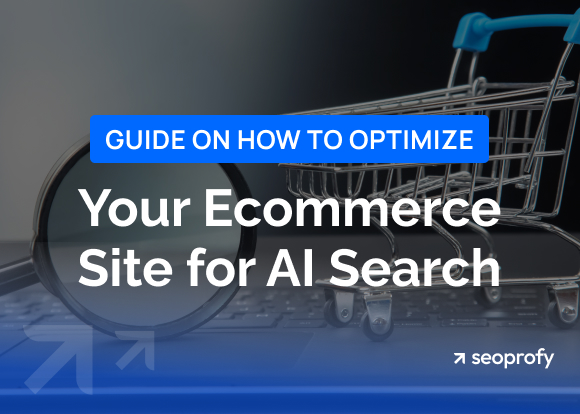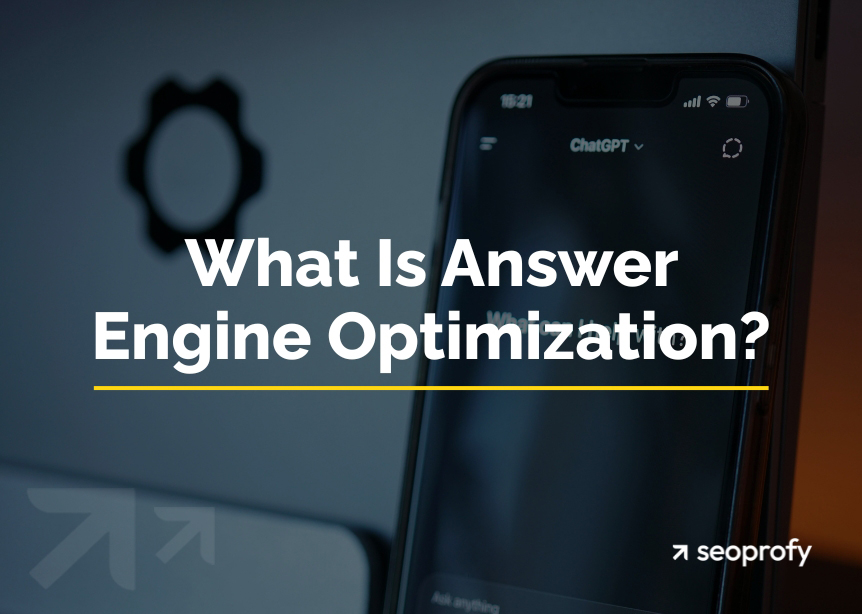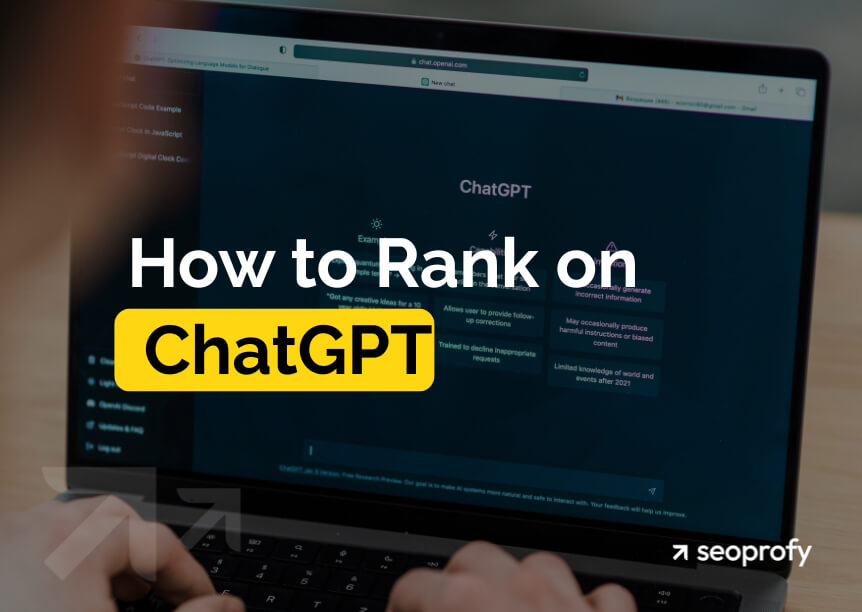Search has changed, and you’ve probably already seen it. Google now shows AI overviews at the top of search engine results pages. That summary pulls from a handful of websites, replacing what used to be the most valuable space on the page. For brands that depend on search visibility, this change has consequences, even for pages that rank well.
In this guide, we’ll explain what Google’s AI-generated summaries are and how they can affect your traffic. You’ll also learn 12 actionable strategies to adapt your SEO strategy for this new layer of search so that you can keep attracting potential customers and remain visible online.
- AI Overviews are a new Google feature that uses Gemini to answer user questions directly in the SERP.
- An Authoritas study found that AI Overviews appeared in about 30% of searches, based on data analysis from users with Google’s Search Labs enabled.
- Getting mentioned in an AI overview won’t always bring more clicks, but it puts your brand in front of more people and can influence their decisions over time.
- Well-optimized websites that already perform in the top 10 results are more likely to appear in AI overviews, which shows that a strong SEO foundation is still important.
What Are Google AI Overviews?
Google’s AI Overviews (formerly known as Search Generative Experience) are summaries that appear at the top of search results. These overviews aim to provide readers quick answers without clicking through. You’ll see them show up in Google’s search like this:
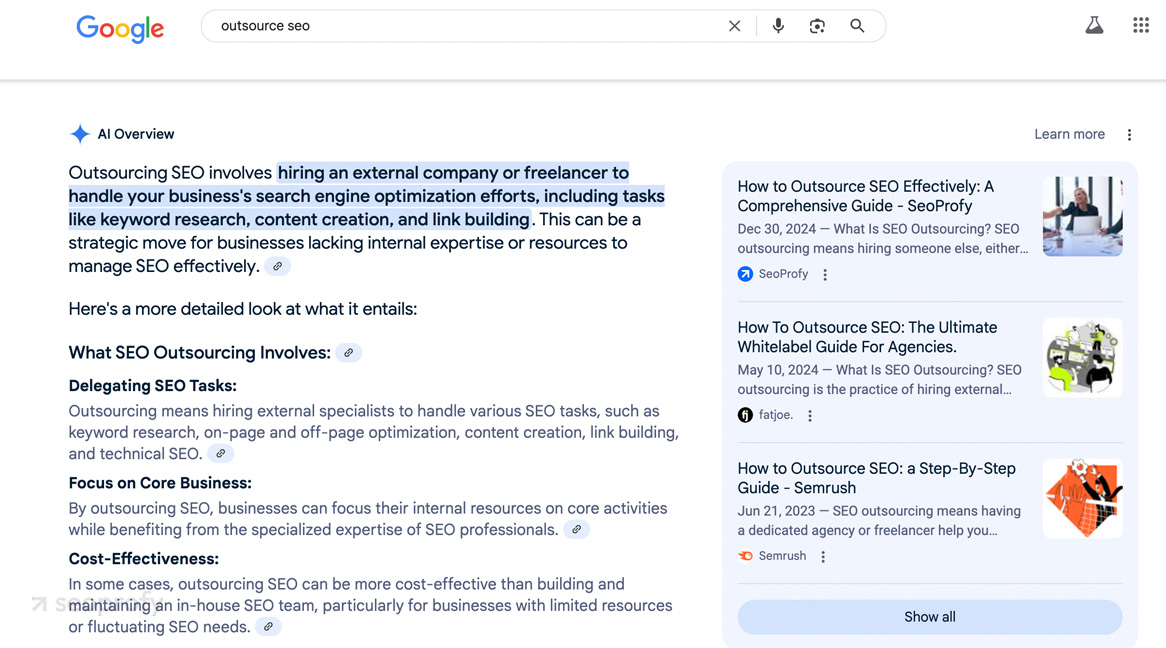
In contrast to featured snippets, which mostly use only one source, AI Overviews pull information from several websites at once. And being cited here can significantly improve your brand visibility, not just for rankings, but for credibility too.
When Do AI Overviews Appear?
Data from Authoritas research suggests that AI Overviews show up in about 30% of all U.S. searches, which is similar to what Ahrefs found. According to their dataset, AIOs appear on 21% of all keywords. What’s interesting is that this number differs hugely by search intent.
As it turns out, most of the AIOs (99.9%) are triggered by long-tail keywords with informational intent. These often include:
- Non-branded keywords
- Question-based searches
- Multi-step instructions
However, the situation looks completely different for other types of intent. Ahrefs’ findings suggest that for commercial queries, the number drops to 5.5%. Transactional sits at 1.2%, and navigational searches trigger them only 0.1% of the time.
If one thing is clear is that AI Overviews favor top-of-funnel, informational content. And even though many brands experience fewer clicks because of this, ranking in AI search results is still important, and in the next section, we’ll explain why.
Why Are AI Overviews Important for SEO?
As you’ve seen earlier in the screenshot, AI Overviews are showing up at the top of search results, above the usual organic links. When your content is selected for one, it gets extra visibility in a prime spot: the top-right corner of the page.
So, brands that adapt to these strategies will certainly have an advantage over those that don’t. As Neil Patel put it:
“The way most people think about SEO is clicks to a website. But if you don’t show up, you are missing out on the opportunity to promote your brand and gain impressions.”
Neil Patel
Being featured in an AI Overview also gives your site authority in your niche. It’s a sign that Google sees your content as the right answer, which can help you gain trust with potential customers.
Even though there’s no shortcut or guarantee to AIO placement, combining traditional SEO with AEO strategies massively increases your chances, and we’ll show you exactly how to do it (with tested tactics) in the sections that follow.
How Do AI Overviews Affect Website Traffic?
Most businesses are concerned about whether these machine-generated summaries cut into their traffic. And the truth is, AI overviews do change how users engage with your website. In some cases, they lead to zero-click searches, where users get the information they need directly from the results pages and don’t visit a website at all.
Ahrefs analyzed 300,000 keywords and estimated that the presence of AI Overviews correlates with a 34.5% lower average clickthrough rate for position one results on informational keywords, compared to what would have been expected without an AI summary.
As Kevin Indig, a growth advisor at HyperGrowth, said on LinkedIn, some websites are seeing “clicks down, impressions up.” This means AI Overviews increase a site’s visibility (your name or link might appear more often), but fewer users visit your site.
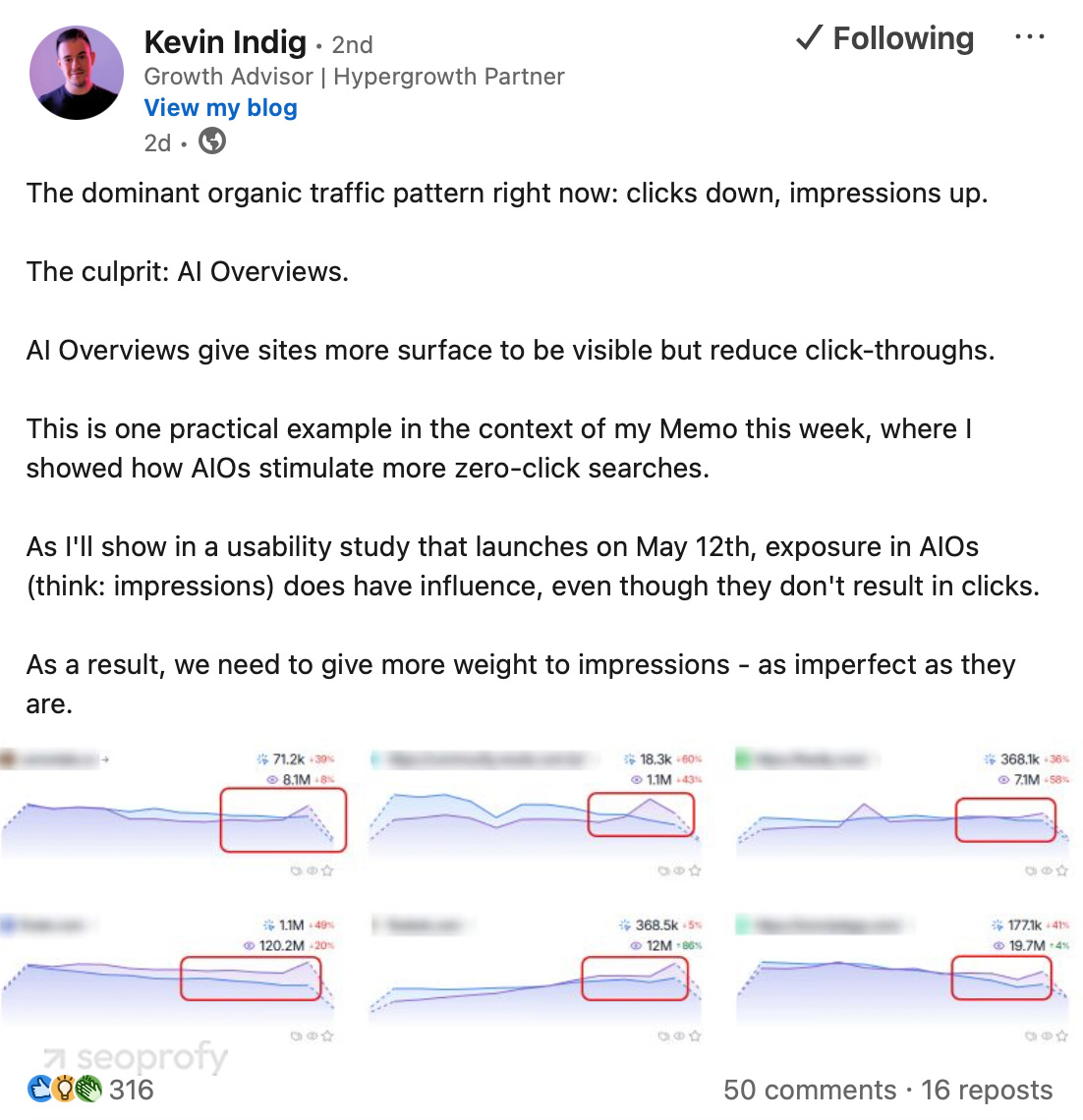
In other words, ranking in AI overviews is a tradeoff: you may lose clicks, but you’re not invisible. And that kind of brand exposure can still influence user decisions later.
Strategies to Get Featured in AI Overviews
A big part of how to optimize for AI Overviews comes from the same technical and on-page work you already use in SEO, paired with elements that sit closer to generative engine optimization (GEO). Let’s look at these step-by-step:
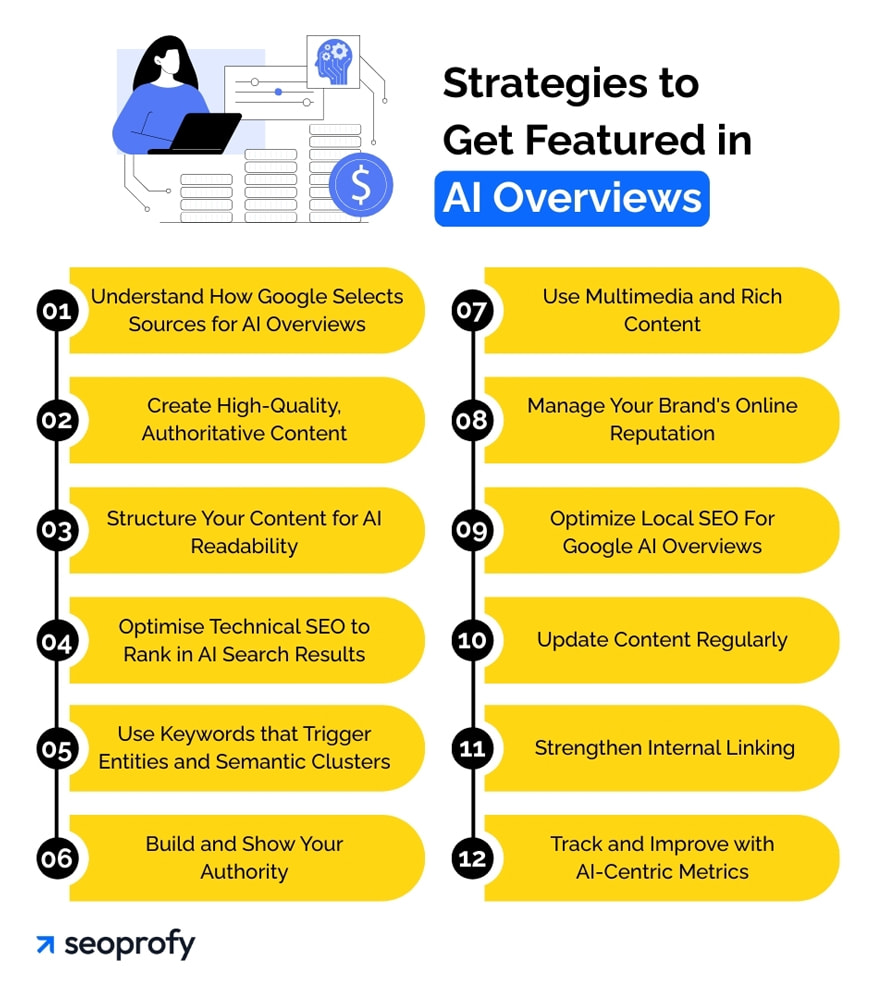
1. Understand How Google Selects Sources for AI Overviews
When a user searches, Google’s proprietary language models — likely based on its Gemini technology — analyze multiple web pages using AI search algorithms to build a concise response that appears at the top of the results.
The sources it pulls from usually rank well for the query in the traditional SERPs, though it’s not always the case. Based on what we’ve seen across clients’ websites and our SEO case studies, pages that tend to be included usually:
- Prioritize search intent: AI models look for content that directly satisfies the underlying intent of a query (the reason why someone searches), not just keyword matching.
- Focus on relevance and context: AI parses semantic meaning, so the content that’s contextually relevant is more likely to be selected.
- Optimize for NLP: Pages written in natural language and answering questions the way a helpful expert would are preferred over those that are only written to rank.
That said, let’s look at several ways you can optimize your site to meet these criteria, along with some AI overview ranking tips.
2. Create High-Quality, Authoritative Content
Pages that show up in AI-driven search results tend to answer the user’s question directly in their content, back it up with context and data, and show signs of expertise. Here’s what that looks like in practice:
- Meet E-E-A-T expectations: Google favors pages written by people who understand the topic. It means you need to publish valuable content that demonstrates authority and first-hand experience to rank in AI overviews.
- Publish original data: If you have your own research, case studies, or survey results, use them. AI models prefer to pull from sources that offer something new rather than repeating the same information everyone else is sharing.
- Start with concise answers: The first 2–3 lines in your pages should answer the main question directly. This format works well for LLM SEO too, since it gives AI models a ready-to-use response that matches how users search.
- Include supporting details: Once you answer, expand with related concerns. Think one step ahead of your reader. What’s the next thing they’d ask? That’s often what gets pulled into follow-up boxes and related queries.
At SeoProfy, we combine time-tested SEO with new strategies built for how AI reads and ranks content. We’ll help you:
- Appear in AI-generated answers
- Build authority as a trusted source
- Grow your visibility online

3. Structure Your Content for AI Readability
It’s easier for AI to extract data from pages that are well-structured and easy to scan. So, when creating high-quality content, organize it for better readability.
One format AI-powered search engines like Gemini love is lists. Surfer’s data found that in 78% of the cases, AIOs contain either an ordered or unordered list. We’ve seen this firsthand, too. In our article on AI SEO statistics, the key takeaway section was displayed almost exactly as written in an AI Overview, pulled straight from our page.
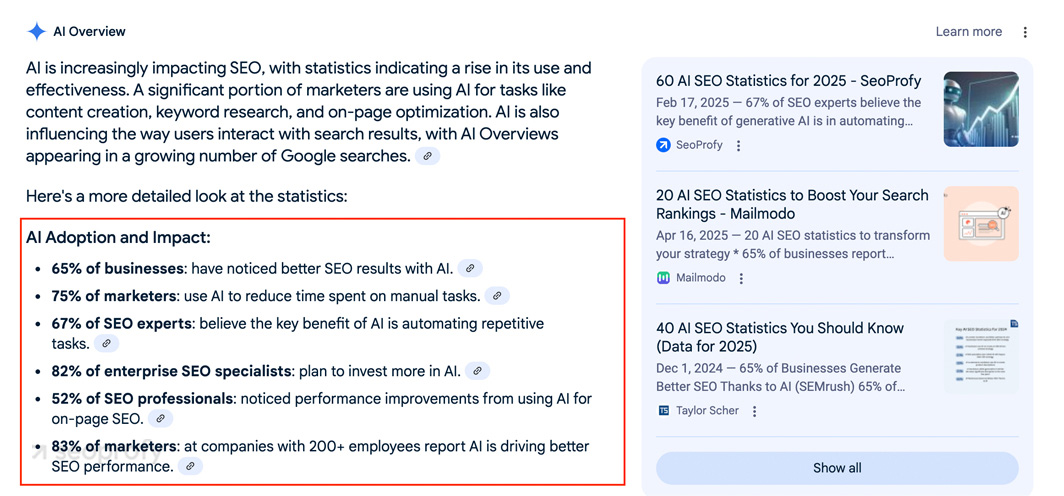
Apart from lists, you could also try these formatting best practices to rank in AI overviews:
- Keep sentences short and use bullet points
- Give direct answers at the top of the page so AI can easily grab them.
- Use Q&A formatting as these are frequently pulled into results.
- Add tables and step-by-step instructions to make it easier for AI to parse.
4. Optimise Technical SEO to Rank in AI Search Results
Your site also has to be technically sound to be visible in Google AI Overviews. Here are the areas you’ll need to monitor:
- Crawlability and indexing: Make sure Google can access your content in the first place. That means the Googlebot shouldn’t be blocked, and your pages need to return a 200 status code.
- Page speed: Run your site through PageSpeed Insights and fix what’s slowing it down. If needed, optimize images and the way your site handles returning visitors.
- Mobile optimization: Prioritize the mobile version of your site, since Google uses it as the main version for indexing and ranking.
- HTTPS: Secure your site with a valid SSL certificate (that little padlock in the browser). It shows your visitors and search engines that your site is trustworthy and helps with SEO.
Another important part of technical SEO when optimizing for generative AI tools is schema markup. It adds structure to your pages and gives your content a better chance to appear in the AI overview section. Here are some of the most common schema types you can use:
- FAQ schema for common questions
- HowTo schema for step-by-step guides
- Product schema for detailed product info
- Organization schema to clarify your brand identity
- Review schema for ratings and testimonials
- Article schema enhancements for extra context
One thing to remember is that the content in your markup should match what’s visible on your page. Google writes about this in its documentation, and also mentions that brands need to validate schema markup through the Rich Results Test.
If you don’t have a team in-house to do the technical optimization, you could always outsource it to an expert SEO agency. That way, you won’t have to worry about breaking anything or wasting time on the hiring process.
5. Use Keywords that Trigger Entities and Semantic Clusters
Gemini and other AI systems don’t just scan your page for one main keyword. They look at the concepts you mention, how they relate to each other, and whether that bundle of ideas matches what the user is trying to do.
If those signals line up, your page is more likely to be pulled into an AI Overview as a “good summary” of the topic. In practice, that means you’re not only targeting a primary keyword. You’re mapping out the entities and semantic clusters around it and making sure they show up naturally in your copy.
How Entities Work on a Page
Think of an entity as a “thing” Google can understand on its own — a product, a feature, a brand, a location, a job role, a task, or a metric. When those entities appear together in a logical way, the model can tell that your page covers the topic in depth. Here’s how you can do it:
- Identify the core entity of the page and add it in the title, H1, intro, and key sections in natural language.
- Layer in related entities and attributes that commonly co‑occur with your main topic to create a dense semantic neighborhood around your page.
- Group close‑variant and intent‑aligned queries into one cluster, then cover that full cluster in one strong page or section.
- Scan the top pages, PAA, and related user queries to see which entities and phrases show up repeatedly, and integrate those naturally into headings, FAQs, and body copy.
- Link between pages in the same semantic cluster with entity‑rich anchor text so crawlers can see how topics and entities connect inside your site.
In short, semantic clusters give AI a map of your content. Pages that show all relevant entities in a structured, readable way appear more authoritative and easier for AI engines to reference.
6. Build and Show Your Authority
You probably already know about E-E-A-T from traditional SEO. It turns out these signals matter just as much for ranking in AI Overviews. The AI-specific E-E-A-T signals focus on the depth and firsthand experience your pages need to show. At the same time, Google still looks for credible citations that mention your brand.
This lines up with what Matt Lerner and Amanda Natividad mentioned in their webinar on Content Marketing in a Post-SEO World. They recommend businesses find relevant and credible websites in their niche and get cited there. Such mentions send strong trust signals to AI tools and carry even more weight, especially in “Your Money or Your Life” topics like health or legal.
To show your credibility and E-E-A-T, try these best practices:
- Add detailed author bios with credentials and links to your professional profiles. If you have certifications, awards, or years of experience, mention them too.
- Use the author property within the Article or BlogPosting schema to provide structured author data.
- Share firsthand experience and write thought leadership content that shows both expertise and depth.
- Cite trustworthy sources in your content and try to get your brand mentioned in relevant external sources.
All of these strategies will help your brand appear more credible online. What’s more, you’ll be able to improve your SEO ROI over time, thanks to the extra search engine visibility your website’s gonna get.
7. Use Multimedia and Rich Content
One of the often-overlooked tactics in how to rank in Google AI Overviews is using multimedia content. Visual elements do more than make your content look good. They help users understand it better and give search engines more context to work with. In fact, AI models can sometimes pull these elements directly into AI summaries.
Depending on your niche, you could add rich content to your pages in several ways. Here are some of them:
- Annotated images and step-by-step visuals: Show people exactly what to do with screenshots that have arrows or labels. AI can recognize these visual cues and feature them in its responses.
- Short instructional videos (30–60 seconds): Record videos that solve one task at a time. Short, task-based videos are easier for AI to summarize and often show up as video results next to AI Overviews.
- Charts, tables, and diagrams: When you compare something on a page, put the main differences like plans or features into a table or chart. This creates structured data blocks that AI can easily turn into bullets or summary lines in an overview.
Add structured data to signal to search engines that something is an image or a video. It doesn’t take much effort, but it can help your content be included in AI-generated summaries.
8. Manage Your Brand’s Online Reputation
Ranking in AI Overviews has a lot to do with how your business appears across the internet. We’ve mentioned earlier that getting cited in credible sources builds trust, but it also increases brand awareness, as more people get to see the name of your company.
Reviews and user-generated content (UGC) are part of this, too. When AI pulls information to build its summaries, it looks at multiple sources. That includes customer reviews from platforms like Trustpilot or G2. So if someone searches for products or services in your category, those reviews can surface in the results.
Other places where it’s worth being present are community platforms like Reddit and Quora. Over the past few years, search engines have given these platforms higher visibility in traditional search results, and, as you can see in the screenshot, AI Overviews are following the same trend.
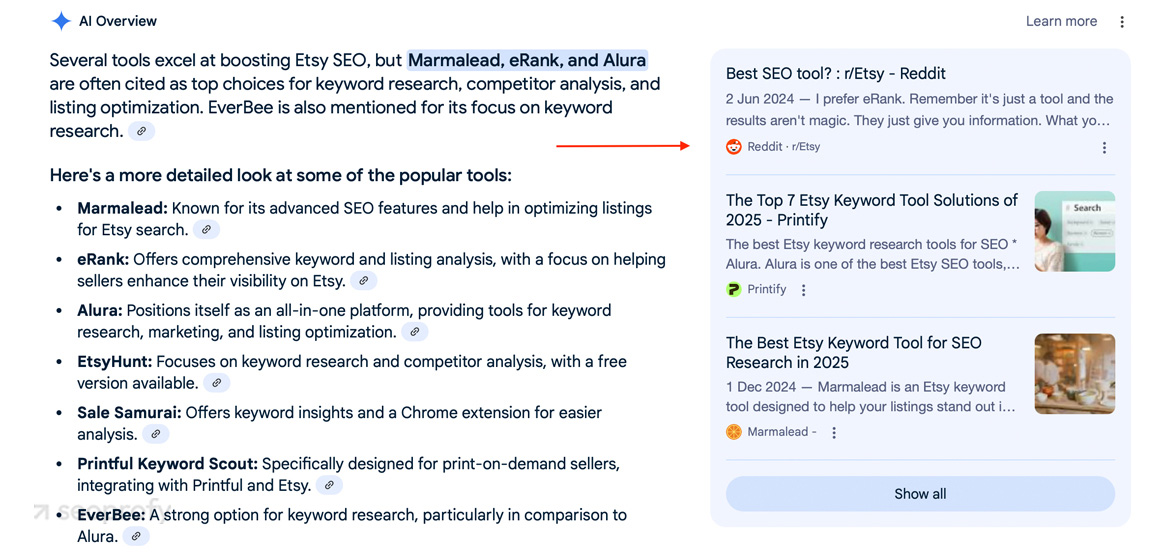
You don’t have to post every day. But answering questions related to your expertise or adding value to relevant conversations can help your content and your brand show up when people search.
9. Optimize Local SEO For Google AI Overviews
Recent data shows that 40.2% of local queries now trigger Google’s AI-generated summaries. This matters if you run any location-based service, because these summaries pull from multiple online sources to give users a snapshot of your business.
From what we’ve seen in our clients’ projects, here are the main areas you need to work on to be more visible in these results:
- Optimize Google Business Profile (GBP): Fill out all the possible fields like working hours, categories, and product or service details. AI systems scan this information to connect the dots on what your business offers.
- Collect and manage reviews: Ask your clients to leave detailed feedback either on Google or any other industry-specific review platforms. The more reviews you have, the more material AI has to work with when someone searches for products or services like yours.
- Maintain consistent store-level information: Check if your NAP details and website link match across directories and your own site. This is not new for traditional SEO, but it also helps AI accurately identify and link your business across sources.
- Add location-specific content on your site: Publish pages and blog posts that reference cities or regions and optimize them with local keywords. It’ll give AI more context on where you operate.
These steps build a strong foundation, but they don’t work once and then get forgotten. Everything from your profile to reviews to website content also needs to be regularly updated.
10. Update Content Regularly
Anyone familiar with SEO knows that Google prioritizes up-to-date content. This applies to traditional search engine results pages as well as AI responses. So, a page that’s frequently refreshed with new information stands a much better chance of appearing in the AI overview section.
One way to stay on top of this is to schedule regular updates. For most niches, this could be every 3 to 6 months. In case your business is in a fast-changing field, you’d benefit from more frequent, monthly audits.
To make it easy for you to manage, you can keep track of it in a simple Google Sheet. After updating, don’t forget to submit the new URL via Google Search Console so Google can re-index it faster.
11. Strengthen Internal Linking
Internal links are an essential element in every SEO campaign setup because they reinforce your topical authority, spread link power, and help users and search crawlers find valuable information. Generative AI models also look at your internal links to find out how each of your pages fits into the broader context of your site.
To build an internal linking strategy that supports better visibility and helps you rank in AI overviews, you can follow these best practices:
- Create topic clusters and interlink related articles: Pages that cover similar angles (pricing, features, or use cases) should link to one another. This shows that your site explains the topic in depth, which can influence how your content is summarized in overviews.
- Fix orphan pages with a site crawl: Use tools like Screaming Frog, Ahrefs, or Sitebulb to find pages that don’t receive any internal links. Then, add relevant links from other pages to help connect them to the rest of your site.
- Strengthen underperforming pages by linking from top URLs: Open Google Search Console or Google Analytics 4 to find your highest-traffic pages, and use them to link to relevant but lower-ranking content.
The final tip is to run a crawl once a month and clean up any broken links or ones that point to outdated pages. This will prevent you from sending users and Google to 404 errors.
12. Track and Improve with AI-Centric Metrics
Just like in traditional SEO, you’ll need to track AI overviews to see your performance. Some of your articles might already appear in the summaries without you knowing. And once you’ve applied some of the strategies above, it makes sense to check whether your content is starting to surface more often.
Luckily, you don’t have to do it manually, as most SEO tools offer this functionality. In Ahrefs, go to Site Explorer, and in the main overview, you’ll see how many mentions in AI overviews you already have:
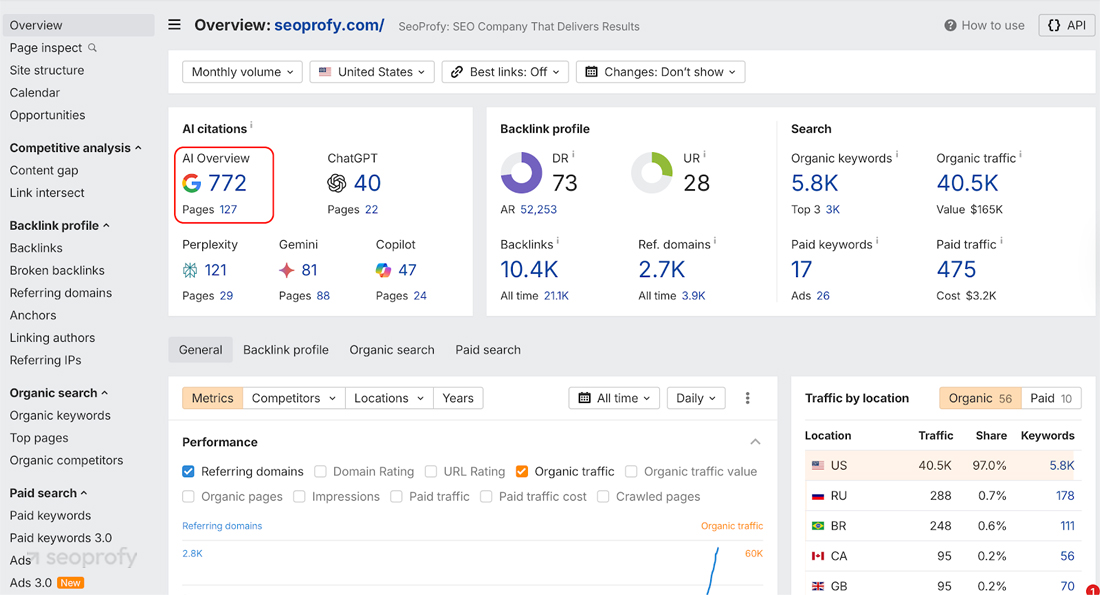
You can click on the number of pages to see which ones trigger an AI summary. To check what queries specifically show up there, you could navigate to the organic keywords report. Here, you can filter them to only see the ones that result in a summary:
- Click on the SERP Features filter
- Select AI Overview from the dropdown
- Look through the keywords

If you want to check your results in real time, you can use plugins. Google AI Citation Analysis and AI Search Impact Analysis show you which keywords are currently triggering summaries and whether your site is mentioned.
Additionally, you could monitor your data and measure SEO in Google Search Console. In the Performance tab, you can find the top queries your site is being surfaced for and the number of clicks and impressions they are getting.
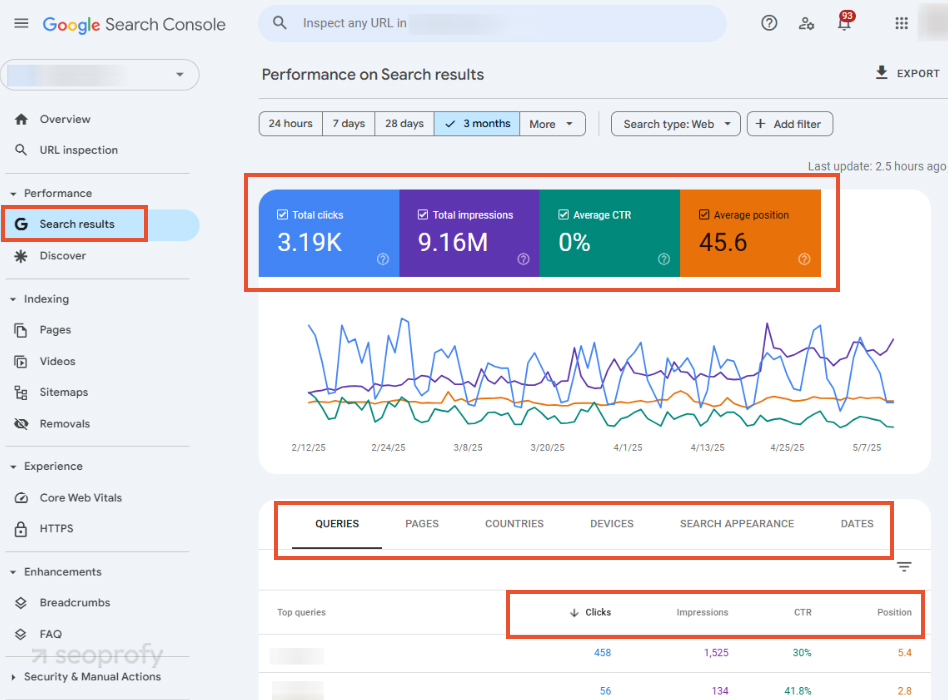
The other section worth looking at is the Enhancements tab. That’s where you’ll see the types of structured data Google has detected. Each one will show a status: valid, warning, or error. If you aim to rank in AI overviews, these need to be marked as valid.
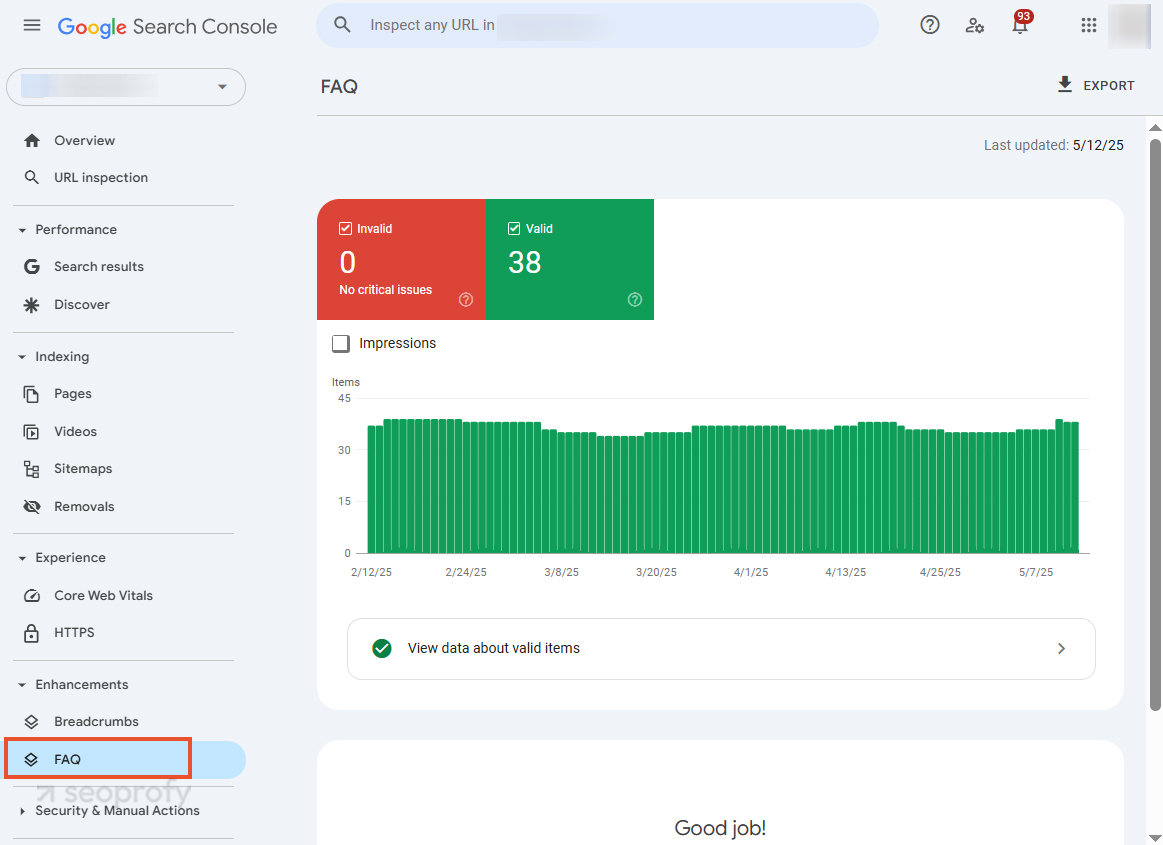
To go into advanced mode with your findings, export your query data from Search Console or Ahrefs and feed it into AI SEO tools like ChatGPT. These can save you the headache of analyzing it yourself and summarize which formats perform best, so you can spot patterns.
Enhance Your AI Citations with Strong SEO Optimization
It’s clear that AI Overviews affect SEO of many businesses and are changing the rules for staying visible in SERPs. Still, one thing remains the same: websites that perform well in traditional search are the ones most likely to be featured in these summaries. And everything we’ve shared in this guide on how to get featured in AI overviews builds on that idea.
That said, if you’re looking to improve your digital marketing and SEO efforts and adapt them for better results, consider our AI SEO services. We create personalized strategies that go hand-in-hand with new advancements and can help you stay visible in this evolving AI search landscape.







